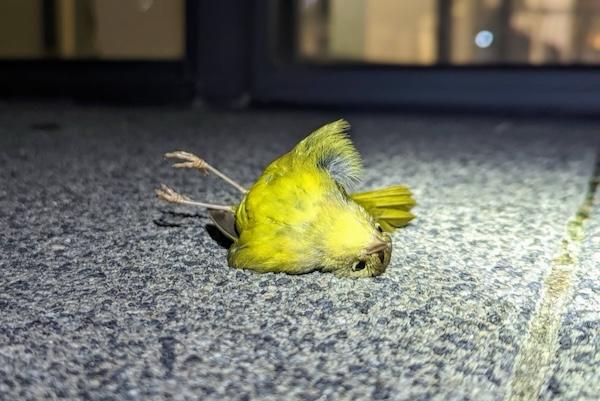
A bird killed by a building collesion in Downtown Dallas was likely drawn into danger by bright city lights. Courtesy of Texas Conservation Alliance.
A recent survey in Downtown Dallas shows that migrating birds continue to die from colliding into buildings every night. But a change for the better may be dawning on the urban landscape.
For five years, a team of volunteers with Texas Conservation Alliance and local partners has walked the streets of Downtown Dallas in the early morning hours during spring and fall migration. They’ve been gathering evidence of an often-overlooked urban crisis: migrating birds killed or injured after colliding with manmade structures. The birds have been diverted from their migration path by confusing city lights.
The Bird-Building Collision Survey is part of the broader Lights Out Texas campaign, an initiative focused on reducing light pollution in cities during peak bird migration seasons. As Community Conservation Director for Texas Conservation Alliance Mei Ling Liu explains, the Dallas survey has added to conclusions from similar evidence gathered elsewhere in the state. “Light is a factor that attracts birds into the city at night during migration,” she said. “But glass is the factor that kills them.”
With statistics showing persistent casualties each spring and fall, Liu says TCA is entering a new phase as its findings have made an impression in the minds of property managers and area municipal decision makers.
A FIVE-YEAR EFFORT WITH A SHIFTING GOAL
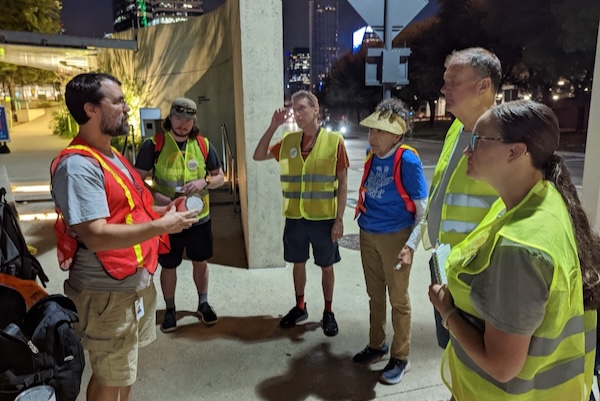 Volunteers prepare to scour the streets of Downtown Dallas in the early morning hours during migration. Courtesy of TCA.
Volunteers prepare to scour the streets of Downtown Dallas in the early morning hours during migration. Courtesy of TCA.
Since its inception, the survey has relied on citizen science, with volunteers gathering data each migration season by searching for dead or injured birds around designated downtown buildings. The protocol solidified in spring 2021, moving from informal routes to systematic coverage of collision hotspots.
“We use the same protocol, survey the same locations,” Liu noted. “But how many birds we find can vary widely — it’s influenced by factors like how many volunteers are involved, and even the weather.”
The data, while not yielding clear year-over-year trends, has served a more important purpose: raising awareness.
“When Lights Out Texas started, most people didn’t know that birds migrate at night,” she explained. “Now, more citizens are aware that light pollution is an issue for migratory birds.”
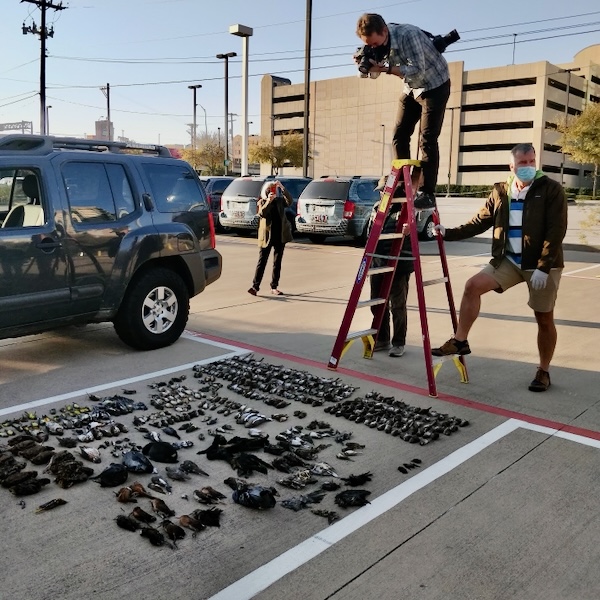 Photographer documents found bird carcasses collected by volunteers. Courtesy of TCA.
Photographer documents found bird carcasses collected by volunteers. Courtesy of TCA.
FROM LIGHT TO GLASS: BROADENING THE MESSAGE
The survey’s findings have shifted the campaign’s message from simply turning off lights to addressing the lethal role of glass windows. Birds, especially small species like buntings, struggle to perceive transparent or reflective surfaces.
“They don’t have the ability to recognize glass as a barrier,” Liu said. “Sometimes they see flowers or habitat on the other side and try to fly through. Reflections of trees or sky can fool them into thinking they’re heading for safety.”
Birds face a double jeopardy in modern cities: artificial lighting disrupts their natural navigation systems during nighttime migration, luring them toward buildings where reflective and transparent glass becomes an invisible death trap.
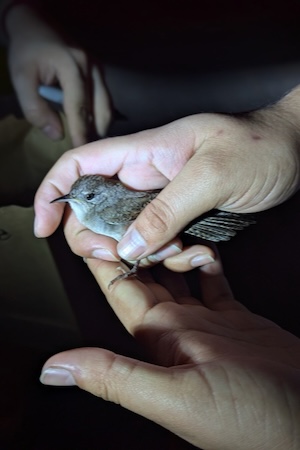 A stunned bird is examined for injuries. Courtesy of TCA.
A stunned bird is examined for injuries. Courtesy of TCA.
Transparent glass allows birds to see vegetation or sky on the other side, creating the illusion of clear passage. Even more deceptive is reflective glass that mirrors trees, water or sky — natural habitats that birds instinctively seek.
“When a lot of birds are foraging near the ground, when they get scared or when predators approach them, they think that they are flying into safe habitat because of the reflection, but they are not,” Liu notes. “That’s how a lot of collisions happen.”
For this reason, TCA advocacy has slightly shifted to emphasize the need for bird-safe glass —glass treated with patterns or markings that birds can see. Decals of predatory birds have been available for decades for placement on windows to ward off birds, but “a single hawk decal in the middle of a giant window doesn’t prevent collisions,” Liu cautioned.
Instead, proven standards like two-inch by two-inch dot patterns, endorsed by groups like the American Bird Conservancy and Feather Friendly, are more effective.
IMPACT AND THE ROAD AHEAD
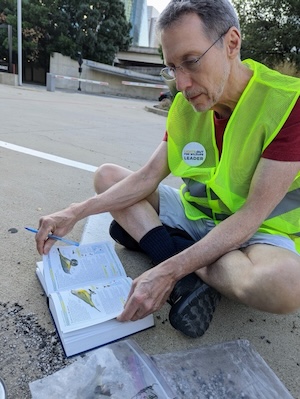 A Bird Survey Leader helps identify bird carcasses. Courtesy of TCA.
A Bird Survey Leader helps identify bird carcasses. Courtesy of TCA.
The Lights Out Dallas effort has sparked regional action, Liu Says, and cities are stepping up and making long-term commitments to support this important work. For example, the Traphene Hickman Public Library in the City of Cedar Hill features bird-safe glass. The City of Frisco has evaluated lighting across its public buildings, while the Cities of Denton and Grand Prairie actively educate residents about light pollution and bird-friendly practices.
Still, the labor-intensive nature of daily surveys — often starting at 6 a.m. — has prompted a reassessment.
“We have enough data to identify hotspots and the worst buildings in downtown Dallas,” Liu said. “Now the question is: do we continue these surveys, or shift volunteer hours to the next stage — using our data to advocate for building changes?”
Starting this fall, the Dallas Zoo will take over coordination of the morning collision surveys, continuing a partnership with TCA and other groups like the Perot Museum of Nature and Science and Trinity River Audubon Center. Meanwhile, broader citizen science platforms such as iNaturalist and D-Bird are under consideration to expand data collection region wide and make participation more accessible, equipping more citizen scientists to document and photograph casualties wherever they’re found.
POLICY AND PUBLIC ENGAGEMENT
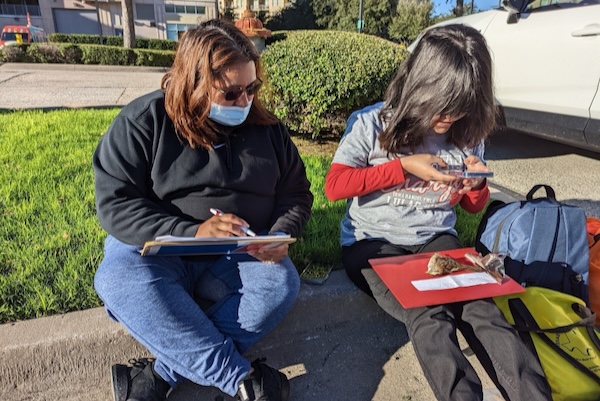 Volunteers document found birds in Downtown Dallas. Courtesy of TCA.
Volunteers document found birds in Downtown Dallas. Courtesy of TCA.
The next major push is on the policy front. With the Dallas Convention Center set for renovation, TCA and partners including Environment Texas and Audubon Texas, are preparing a petition to urge the city council to require bird-safe glass in the new design.
“It’s cheaper to do it from the beginning,” Liu said. “If you retrofit, it’s much more expensive.” The campaign will roll out at the end of June 2025, seeking public support ahead of key city council sessions.
Liu says the effectiveness of this approach has been dramatically demonstrated in other major urban projects. The Javits Convention Center in New York City transformed from "the number one bird killer building" to an urban oasis for birds after installing bird-safe glass and creating rooftop habitat. Similar success has been seen at McCormick Place in Chicago, proving that cities can coexist safely with migrating wildlife.
“People care about these causes,” Liu said. “And together, we can make Dallas safer for birds on their long journeys across the continent.”
Courtesy of TCA.
RELATED ARTICLES
'Lights Out Texas' aims to save migrating birds
Migrating bird deaths documented in downtown Dallas
'Lights Out Texas' is for the birds
Downtown Fort Worth to dim lights to help migrating birds
Dead bird count in Dallas informs light pollution campaign
'Lights Out' campaign is gaining momentum, say organizers
How light pollution messes with Texas wildlife
